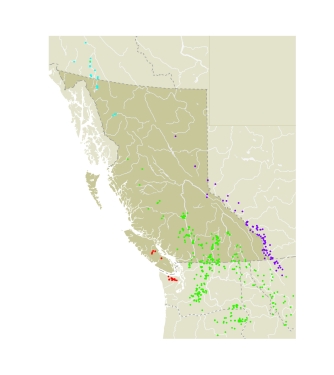The name Parnassius is derived from the Parnassus mountain range near Delphi in Greece, in reference to the alpine habitats of most species (Emmet 1991). Linnaeus divided butterflies into several groups, the second of which was the Heliconii, which took their name from the Muses and Graces that lived on Mt. Helicon, the highest peak in the Parnassus range. Apollo was the patron god of the Muses and Graces, and the first species of Linnaeus's Heliconii was Papilio apollo (Emmet 1991), now known as Parnassius apollo. The common name "apollo" was first applied in Britain by British lepidopterists to the one species P. apollo (Bretherton 1990a), and was later extended to apply to the genus as a whole.
Apollos are medium-sized to large white or yellow butterflies with black wing markings. Red eyespots are usually present on the hindwings and, in two species, on the forewings. The outer borders of the wings are semi-transparent due to lack of scales. Two hooks on the forewing base help in the emergence of the adult from the pupal cocoon (Scott 1986b). Females have a brown or white sphragis, a hard structure deposited in the female mating tube by the male during mating to prevent further matings.
The abdomens of the males are very hairy, possibly to reduce heat loss during their long flights searching for females. In contrast, the abdomens of the females are naked or sparsely haired, possibly enabling them to reduce overheating on the hot ground, where they spend most of their time.
Unlike most butterflies, the eyes of males are much larger than those of females. It is unlikely that the only reason for this is that males locate females visually at a distance, because that is true for most butterflies. It may be correlated with the lack of courtship prior to mating: a male simply grapples with a female as soon as he spots her, and attempts copulation. If the female has already mated, the male attempts to grasp the sphragis with his claspers and remove it (CSG).
Eggs are round with a pebbled or pitted surface, and are white to tan in colour. They are laid singly under the edges of objects in the general vicinity of the larval foodplants. Phoebus Apollos may lay eggs directly on the larval food plant (Shepard and Manley 1998). The embryo develops into a larva within the egg chorion within a few weeks of oviposition, but the egg does not hatch until the following spring (Edwards 1868-72).
The larvae have small, vestigial osmeteria (Y-shaped, eversible defensive secretory glands) on the top of the thorax; these are frequently not everted when a larva is "attacked" with forceps, and do not produce any chemical secretion. Pupation occurs in weak cocoons in loose soil or debris on the ground.
|
